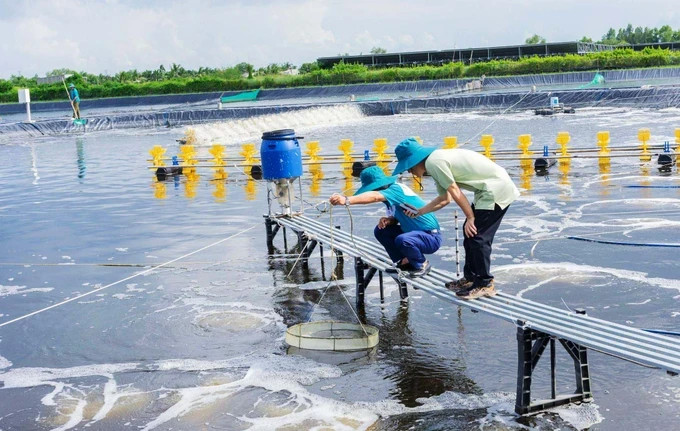
Huynh Thai Nguyen in Hung My Commune of Cai Nuoc District (Ca Mau Province) realizes after 20 years raising shrimp that each model or technique has its own weaknesses like environmental pollution, disease spreading, high cost for water treatment, unstable shrimp quality, and high overall cost.
However, now he is learning about the piloting super-intensive model introduced by the Science and Technology Department of Ca Mau Province and the Research Institute for Aquaculture No.2. This model is used to raise commercial white-legged shrimps in three phases via circular technology, which is biologically safe.
He has invested VND2 billion (US$82,380) to construct the shrimp farm inside a surface area of more than 1ha, consisting of one nursery pond, one pond to process input water, two Gracilaria tenuistipitata ponds, one tilapia pond, one biological filter ditch, one bioflocs ditch, and four shrimp ponds with a surface area of 1,000m2 each. Shrimps can be collected after 90 days, reaching a weight of 26 shrimps per kilo.
The new model increases the output by 20 percent to 60 tonnes per hectare. In addition, the shrimp growth rate rises while the feed ratio, cost of input water treatment, labor to operate the system all reduce. There is no need to use antibiotics, but diseases still decrease, and no wastewater is released into the environment.
Traditional shrimp raising models like extensive farming, improved extensive farming, or intensive farming mostly result in low outputs and are easily affected by environmental factors. Instead, the cutting-edge model of super-intensive farming is preferred in the Mekong Delta thanks to its closed circular farming inside a greenhouse through two or three phases. It effectively implements state-of-the-art digital technologies like cloud computing and AI to better control environmental factors and diseases to bring back economic efficiency to farmers.
Lately, many shrimp farmers have visited Farm Salicornia in Duyen Hai District of Tra Vinh Province to learn the super-intensive oxygen-rich white-legged shrimp raising model called Tomgoxy. The model is developed by Rynan Technologies Vietnam JSC., integrating AI and other physics – chemistry – biology knowledge.
With an app installed on a smart phone, farmers can control provided measuring and testing devices to monitor the water quality and shrimp health. Diseases can be easily detected for timely handling, greatly saving costs and increasing the output from 40 percent to 70 percent. The app also logs daily farming activities in each pond thanks to its assigned identity code for easy tracking purposes. These valuable data can be then used for safety certificate registration or traceability.
The system uses alternative energy and exploits available natural resources plus automatic operation management via IoT devices to optimize costs.
Shrimp raising is one main job of farmers along coastal areas in the Mekong Delta. The National Action Plan by the Prime Minister to develop this industry states that until 2025, the brackish water shrimp export turnover will reach $8.4 billion (compared to the figure of $4.3 billion in 2022) and the total brackish water shrimp farming area will be 750,000ha for an output of 1.1 million tonnes.
The shrimp raising industry is facing various challenges, including price competitions against Ecuador, Bangladesh, and India.
Director Phan Tan Thanh of the Science and Technology Department of Ca Mau Province said that agriculture - forestry - fisheries are the strengths of his province. Therefore, most scientific projects done here focus on these aspects. At present, the implementation of AI and other advanced technologies in shrimp raising is necessary to precisely control disease and environmental factors, leading to a reduction of operation and labor costs and ultimately of retail prices.
Chairman of the People’s Committee of Bac Lieu Province Pham Van Thieu stated that his locality is trying to become the shrimp raising capital of the country. It will soon introduce its Hi-tech Industrial Park for Shrimp Raising to promote the model of hi-tech shrimp raising households. The province is going to develop and carry out disease monitoring programs. Businesses here will receive support to form a disease-free shrimp production chain in order to obtain the certificate from the World Organisation for Animal Health (WOAH) to have a better chance to export shrimps to picky international markets.
Source: SGGP